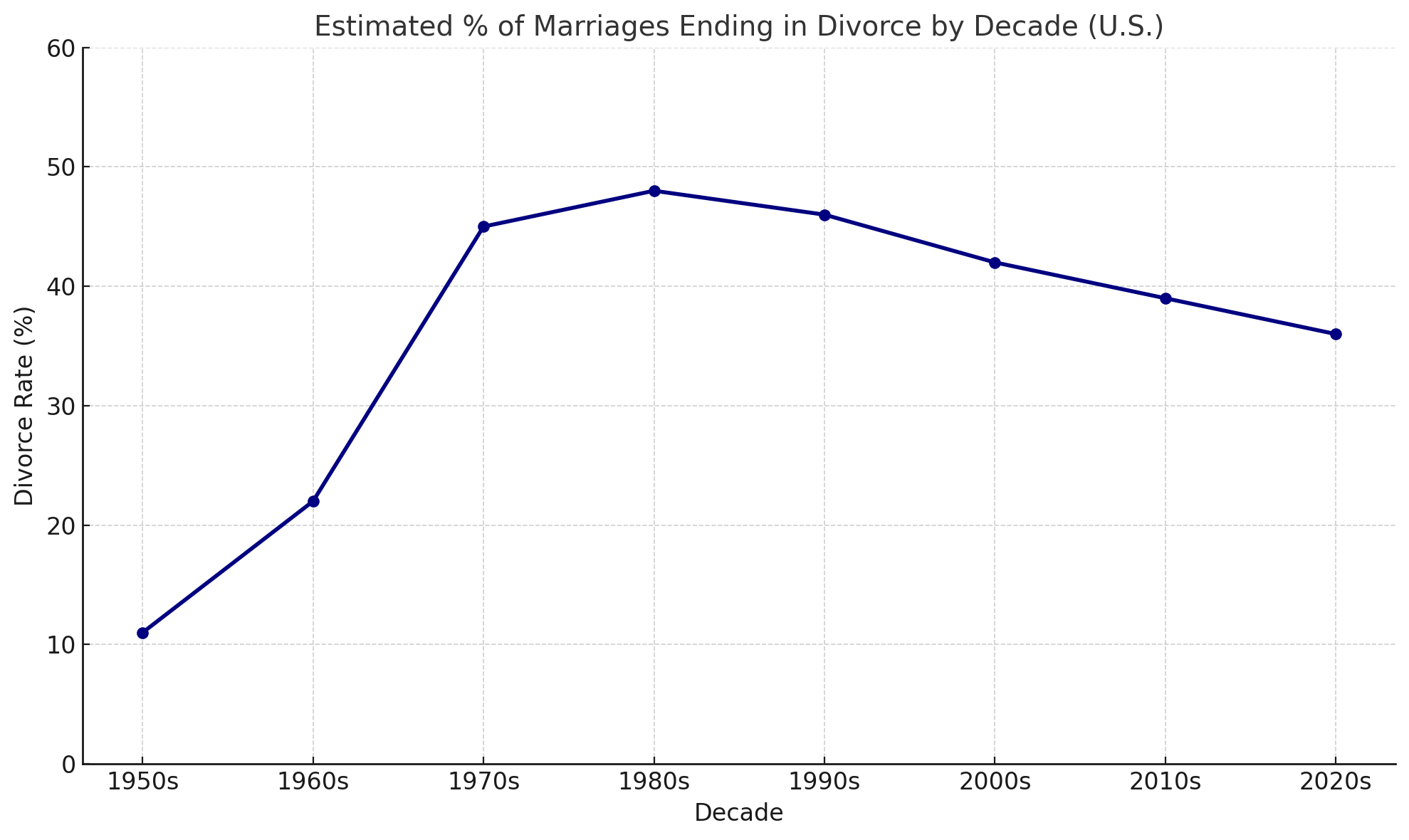How Many Marriages End in Divorce?
How Many Marriages End in Divorce? Understanding the Modern Divorce Landscape
Divorce has long been a cultural touchpoint and a legal milestone — and in recent years, it’s also become a subject of growing curiosity. People want to know: how many marriages end in divorce today? How do we compare to past generations? What’s driving the decline in divorce rates? And what does it mean for couples in Illinois?
This guide explains the most recent divorce statistics, evolving causes of marital breakdown, how remarriages and money issues play a role — and what you can do to protect your relationship and your legal rights.
Divorce in America: A 70-Year Trend
From taboo to common — then slowly back down again.

1950s: Divorce was rare. Only about 10% of marriages ended in separation. Strict gender roles, religious norms, and social stigma kept most couples together.
1970s–1980s: Divorce rates soared to nearly 50%, fueled by:
- The no-fault divorce revolution
- Growing women’s economic independence
- Cultural acceptance of separation as a personal choice
1990s–2000s: Rates stabilized at 45–50% nationwide.
2020s: Today, approximately 39% of marriages end in divorce — and the trend is slowly declining. Millennials and Gen Z marry later, often with stronger communication tools and shared responsibilities.
Is Divorce Still Common in Illinois?
In Illinois, the divorce rate closely mirrors national averages but with some regional variations.
According to recent public records:
- Illinois had 23,000+ divorces filed in 2020
- Chicago and Cook County account for a large share due to population density
- Remarriage and blended family dynamics are increasingly common
While national trends show a dip, Illinois divorce courts remain active, especially in urban and suburban communities.
Why Are Fewer Marriages Ending in Divorce Today?
Modern couples are approaching marriage with more caution and intention. Several factors contribute to the falling divorce rate:
- Later marriage ages (30+ on average in the U.S.)
- Increased cohabitation before marriage
- More relationship education and premarital counseling
- Higher rates of financial planning and joint decision-making
That said, second and third marriages still carry a higher risk of divorce, especially without legal preparation like premarital and postnuptial agreements.
Common Reasons for Divorce in 2024
Despite declining numbers, divorce remains a reality for many. Based on national research and client experiences, the most frequently cited causes include:
- Lack of commitment
- Frequent arguing and poor conflict resolution
- Infidelity or breach of trust
- Substance abuse
- Incompatibility
- Money issues, such as:
- Financial infidelity (e.g., secret accounts or debt)
- Disagreements over spending/saving
- Unequal financial contributions
These issues often lead to emotional strain, resentment, and — ultimately — divorce filings.
Money Problems: A Leading But Underreported Cause
Financial stress is one of the top predictors of divorce, but it’s often masked by other surface-level complaints. Many couples separate due to:
- Hidden spending or debt (aka financial infidelity)
- One partner controlling finances
- Major income disparity or job loss
In Illinois, financial disclosures are a key part of divorce proceedings — and your attorney can help uncover hidden liabilities or assets early in the process.
What About Divorce in Second and Third Marriages?
- Second marriages have a divorce rate around 60–67%
- Third marriages fail at even higher rates — up to 73%
- Causes often include:
- More complex family structures
- Blended children and parenting conflicts
- Financial baggage from previous relationships
Prenuptial or Postnuptial agreements can help protect both partners and reduce future disputes.
Prenuptial Agreements: A Rising Trend
Many couples now sign prenuptial agreements — contracts created prior to marriage that outline expectations for finances, property, and spousal support. These legal tools help:
- Prevent conflict over assets
- Clarify financial obligations
- Protect individual property in case of divorce
They’re especially common in second marriages or when one partner owns a business or receives an inheritance.
Thinking About Divorce in Illinois? Here’s What to Know
If you’re in Illinois and contemplating divorce, it helps to:
- Review your legal rights and obligations
- Understand Illinois’s no-fault divorce laws
- Consider mediation or collaborative divorce for less adversarial solutions
You don’t have to do this alone.
Get Trusted Legal Guidance with Conniff & Keleher Family Law
At Conniff & Keleher, LLC, we help Illinois residents navigate divorce with clarity, confidence, and compassion. Whether you’re exploring separation, remarriage, or need to revise a previous agreement, our attorneys are ready to help.
📍 Serving Chicago & surrounding counties
📞 Schedule a consultation today
Further Reading & Resources
